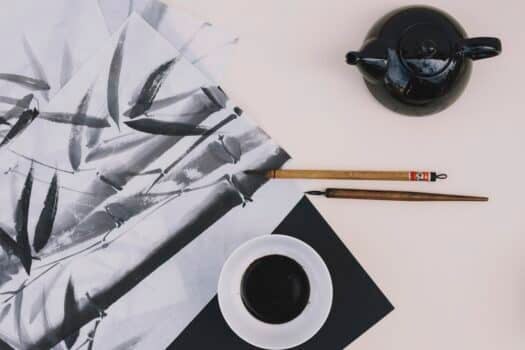Ink pens drawings are a popular drawing style, and you can draw with one using methods like hatching, contouring, and stippling or a combination of these. Besides, these pens can be used to create lines with varied thickness to give the drawing more texture.
Ink art and inking pens have been used for various artworks throughout the history of art. As accommodating as the art style is, it leaves enough room for the artist to personalize their sketches.
Since ink is an easily available medium, it enables a beginner to try it out without having to invest a lot of resources for the art supplies. If you are a beginner wanting to try these ink techniques out, this guide has all the information you’d need.
Pen And Ink Drawings

Artists have different mediums that they use to create their artwork, with one such popular medium being ink. Ink pens, or dip pens, are usually used to create detailed cartoon-like sketches. A popular use of pen and ink drawing is Japanese manga. The ink artists, also known as mangakas, use this style of art to create their comics.
One of the first ink pen art that still exists is The Abduction of Briseis. This was done by an unknown Greek artist around 300 BC. Later on, Leonardo da Vinci created his artwork Five Grotesque Heads using the very same method during the era of the Renaissance.
Pen and ink drawing is a type of art that managed to survive various art movements and is a popular choice of art style to this day. Few artists that have used this style of pen and ink sketches are Michelangelo, Van Gogh, Picasso and Rembrandt.
The most commonly used color for this type of ink sketching is black. Though there are various colors of ink available, black is a popular choice as it has a higher contrast when used on white paper, giving the images more clarity and detail.
Pen and Ink Drawing Techniques
There are different techniques used by artists to make a ink pen drawing, with the most common ones including:
1. Hatching
Hatching is by far one of the most basic and commonly used pen and ink drawing techniques. It is done by drawing straight lines in the same direction. Drawing the lines closer together will give your sketch an effect of darker shading. Similarly, drawing the lines far apart will give it light shading.
Beginner artists prefer to use a ruler to get a more structured finish on their lines. However, if you like the lines being a little messy, you can “rule” out a ruler (pun intended).
2. Cross-hatching
Cross-hatching can be very similar to normal hatching except, as the name suggests, the lines cross each other. These lines go in opposite directions. You can start with a layer of normal hatching and then proceed to do another layer of hatching but this time in the opposite direction.
Cross- hatching helps give the ink pen drawing more texture and makes the shading a lot more dense than hatching. It is used mainly for showing natural textures like scales or rough skin.
3. Contour
Contour is used to give more attention to shapes and unlike hatching, contour lines are curved. This helps create a deeper shadow and brings out the shape of an object. Placing the lines closer together will give the contour a darker shadow and vice-versa. Contour can also be used to change the shape of something and give it an illusion of another shape.
4. Cross-contour
Cross-contour is a mix of cross-hatching and contour, as the lines are curved and cross each other, thus giving the sketch a denser contouring. This ink technique is primarily used to bring out shapes in a more prominent way.
5. Random Lines
There are many textures in an ink drawing, and artists can use this pen and ink drawing technique to create various exciting textures. This gives the drawing a more natural and relaxed look. Random lines can be one big stretch of a line or individual lines that cross each other or curve at random places.
This technique, however, might take longer to master than the other ink drawing techniques. But, once you get the hang of it, it can produce some brilliant artwork that has intense textures and shading.
6. Stippling
Stippling is the art of adding several tiny dots to the sketch to give it an illusion of texture and depth. Highly concentrated dots give the drawing deep shadows, while dots that are spaced apart help create softer tones.
This ink drawing technique is commonly done using a finer nibbed dip pen. The very fine nibs give the sketchers more control over the dots and help create a more structured pen and ink drawing.
7. Circular
Circular patterns are used to create various intensities of shadows in a pen and ink drawing. The patterns help create lighter shadows that progress into darker ones or vice versa. This technique is used to make the drawing more natural and helps create textures like scales and foliage.
8. Thick And Thin Lines
With this ink technique, varying the applied pressure will produce lines of various thickness and different line weight. Applying more pressure can give you thicker lines whereas lighter pressure will give thinner lines. These lines can be used to give the final image more shadow intensity. Thicker lines give a denser shadow and vice versa. Line width however, does not fall under the most common ink techniques.
Pens Used For Pen And Ink Drawings

Apart from ink, another important aspect of a pen and ink drawing are the right tools. When it comes to choosing the right pen, it can be confusing. There are different pens that produce different results. Artists use multiple types of pens in one drawing and develop their own personal style. Some examples are fine line pens, ballpoint pens, brush pens, etc.
1. Fountain Pens
Fountain pens, also known as dip pens, might be the most familiar pen on this list. They are extremely versatile and enable the artist to use different colors for their sketches. It might take slightly longer to master the fountain pen as compared to the other pens, but it helps produce vivid and unique pen and ink sketches. Refer to our article “how to change fountain pen ink” to learn how to use a fountain pen.
You will find many fountain pen types out there, so don’t be afraid to experiment!
2. Fineliner Pens
Fineliner pens have very fine nibs and are used for drawing hatched or contour lines with precision. They are also the most common choice when the sketch needs more detail. Since fineliner pens produce precise thin lines, artists opt for these pens for more structured architectural sketches. Besides, they are relatively easier to use than a fountain pen and are an ideal choice for a beginner.
Most fineliner pens happen to be waterproof, meaning the artist can experiment with different mediums like watercolor or ink washes after their initial sketch. They also don’t use more ink when compared to fountain pens.
3. Brush Pens
Brush pens are exactly what their name suggests: a mix of a pen and a brush. These pens offer artists more control over their work as compared to a regular paint brush. They also help experimenting with various line widths and sizes. Applying more pressure can give you a thicker line while less pressure gives a thinner line. These pens help most artists gain more knowledge of line intensities and offer more opportunities for the artist to experiment.
Types Of Papers
Once you find the right pen, it is important to get good paper that suits pen and ink sketches. Remember that the wrong kind of paper will invariably waste your efforts.
Since ink is a medium that can splatter and spread, a paper that is thick enough to hold the ink is necessary, as thinner papers will result in the ink blotting. As such, any paper that is thicker than 70 GSM will be a good place to start.
You can also opt for artist-grade papers. They have a high-quality construction and can ensure that the ink doesn’t blot or spread, thus giving you a better end result.
Types Of Ink
Inks are a mix of dyes or pigments with a binder like water-soluble resin, shellac, or acrylic. Different mixtures give out different inks with varying characteristics. There are many kinds of ink available on the market. Here are a few:
1. Writing Inks
Writing inks are generally made up of dyes rather than pigments. To find out whether your black ink is made with dye or pigment, you can place a drop on a wet tissue paper. If the ink breaks into components of different colors, it is a dye. And if the ink spreads and turns into a light gray at the edge, it is a pigment.
2. India Ink
India ink is by far the most popular choice when it comes to inks. They are easily available and come in different tones of black. You can find these in their solid or liquid forms, and you can also choose between waterproof inks and non-waterproof ones.
3. Acrylic Inks
Acrylic inks are synthetic inks that are made with pigments and fluid acrylic-polymer emulsion. They are quick drying and often waterproof and also dry with a satin finish giving your drawing a more glossy look.
How To Draw With Ink
Once you have all the materials and are aware of all the different ink drawing techniques, you can start creating your masterpiece.
1. Sketch First
If you are a beginner, sketching your ideas with pencil before you draw with ink would be a smart thing to do. This helps you avoid mistakes and get a clearer idea on what your end product should look like. Once you have a rough sketch, you can go over it with ink and add precise details where necessary.
2. Use Ink Wash
Ink wash is a very popular technique among artists. If you like the style of watercolors, you can replicate the same using ink and water. Once you have your ink drawing, add water to the paper to create different intensities of shadows and gradients.
If you want the shadows to have deeper intensity, you can add a higher concentration of ink. Similarly, lighter shadows and softer tones can be achieved using less ink.
3. Learn The Pen Hold
The way you hold your ink pen matters a lot when it comes to pen and ink drawings. Holding the pen loosely on its end will help the artist gain more control over the sketches. Likewise, holding the pen at a higher angle will give more natural lines and curves to the drawing.
4. Utilize Dry Pens
If you have an old ink pen or brush pen that is dried up, don’t throw it away. You can use it as a dry pen to create a brush-like stroke for your textures. This can help add more texture to your sketches and give a more professional end product.

How To Draw With Ink Pen Conclusion
Pen and ink drawings are, to this day, one of the most popular drawing styles. They are the best medium to use if you want a more detailed and unique sketch.
On that note, we hope that this guide helped you gain insight on ink sketching and how you can create a beautiful ink sketch at your home. Happy drawing!


